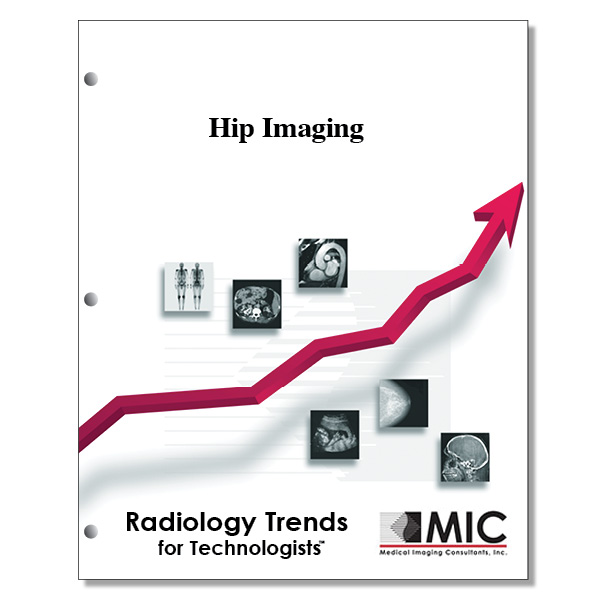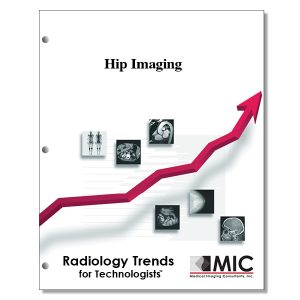

Hip Imaging
Discussion of technical advances in hip imaging covering the roles of radiography, CT, US and MRI.
Course ID: Q00381 Category: Radiology Trends for Technologists Modalities: CT, MRI, Radiography, Sonography4.25 |
Satisfaction Guarantee |
$39.00
- Targeted CE
- Outline
- Objectives
Targeted CE per ARRT’s Discipline, Category, and Subcategory classification:
[Note: Discipline-specific Targeted CE credits may be less than the total Category A credits approved for this course.]
Computed Tomography: 1.00
Procedures: 1.00
Head, Spine, and Musculoskeletal: 1.00
Magnetic Resonance Imaging: 2.00
Procedures: 2.00
Musculoskeletal: 2.00
Radiography: 0.75
Patient Care: 0.25
Patient Interactions and Management: 0.25
Procedures: 0.50
Head, Spine and Pelvis Procedures: 0.50
Registered Radiologist Assistant: 4.25
Procedures: 4.25
Musculoskeletal and Endocrine Sections: 4.25
Sonography: 1.00
Patient Care: 0.25
Patient Interactions and Management: 0.25
Procedures: 0.75
Superficial Structures and Other Sonographic Procedures: 0.75
Outline
- Introduction
- Labrum
- Imaging
- Pitfalls
- Articular Cartilage
- Imaging
- Cartilage Mapping
- Femoroacetabular Impingement
- Background
- Acetabular Retroversion
- Acetabular Depth
- Geometric Deformities of the Femoral Head and Neck
- Assessment of Cam-Type Deformities
- Threshold Dilemma for the Alpha Angle
- New Insights form Asymptomatic Volunteer Studies
- New Ways out of the Controversy
- Miscellaneous Structures
- Ligamentum Teres
- Synovial Folds
- Bursae
- Acetabular Fossa
- Microinstability
- Extracapsular Ligaments
- Iliocapsularis Muscle
- Abductor Tendons
- Summary
Objectives
Upon completion of this course, students will:
- be able to describe the classification of the hip joint
- understand which of the new medical imaging modalities play a role in diagnosing hip trauma and pathology
- be able to describe the anatomical components of the acetabular labrum
- be able to describe the prevalence of acetabular lesions in the elderly patient population
- be familiar with which medical imaging modality is most relevant for the assessment of acetabular labrum integrity
- understand the anatomical quadrants that make up the acetabular labrum
- be able to describe which MR sequences are preferred for depicting a labral tear
- know what portion of the population lacks the anterior portion of the acetabular labrum
- be able to describe various anatomic variants that may be mistaken as labral tears
- be familiar with the anatomical variants of the acetebular labrum that may be visualized on an MR exam
- know the function of the articular cartilage of the acetabulum
- understand the clinical importance of cartilage delamination
- know the various classification systems for determining the degree of osteoarthritis in the hip with conventional radiography
- understand the role of dGEMRIC
- be able to name the anatomic variants of femoroacetabular impingement
- be familiar with the clinical radiographic sign indicative of an acetabular retroversion
- know the specificity and a sensitivity of the ischial spine sign
- describe coxa profunda
- describe protrusio acetabuli
- define the Wiberg angle on conventional hip radiographs
- know which MR reformations are used for patients who may be surgical candidates for osteochondroplasty of the femoral head neck junction
- know what type of deformity a “pistol grip” radiographic sign depicts
- describe where the maximum cam-type deformity of the femoral neck is located
- name the angle used to quantify the degree of femoral deformity on both conventional radiography and MR imaging
- understand the use, application and limitations of sonography for hip imaging
- describe cam-, pincer- and mixed-type impingements
- know which medical imaging techniques are used to identify the alpha angle measurement
- know the cutoff value that is most often used in both orthopedic and radiology literature for the alpha angle
- name other measurements used in various medical imaging procedures that have been investigated to assess cam-type deformities in the femoral head
- know the surgical procedure that an orthopedic surgeon should consider if a patient presents with a cam-type FAI and substantially reduced femoral antetorision
- be familiar with the miscellaneous anatomic structures of the hip joint such as the ligamentum teres
- know the name of the ligament that is ruptured when a hip dislocation occurs
- understand the miscellaneous anatomic structures of the hip joint and their functions
- list the three synovial folds that are visualized on MR arthrography
- name the synovial fold which is more prominent around the femoral neck
- know on what portion of MR hip arthrograms the pectinoveal fold can be identified
- name which bursa lies between the musculotendinous portion of the iliopsoas muscle and the hip joint capsule
- understand which disease processes the presence of hip bursae can be indicative of
- know which fossa lies in the medial part of the acetabulum and is surrounded by the lunate surface and covered by articular cartilage
- know the name of the strongest ligament in the human body
